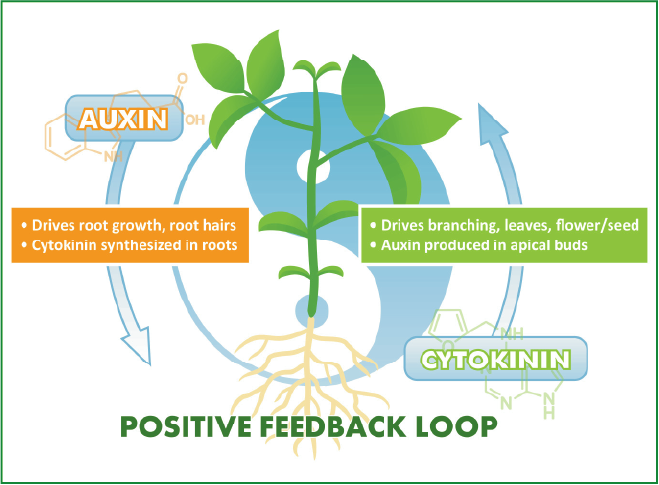

The use of plant growth hormones to improve crop production is evolving from a “let’s see what happens” attitude to a reliable management tool that produces consistent physiological responses in the plant. Understanding the prevalent types can help you get the most from these powerful molecules, from improving your crop’s stress tolerance to increasing water and nutrient efficiency.
WHAT ARE THEY?
Plant growth hormones (PGHs, commonly referred to in the broader category of PGRs or “regulators”) are the commercially available form of naturally occurring plant phytohormones. PGHs are not nutrients; they make nutrients work better, signaling various crop functions from germination to maturity.
There are five primary groups: auxin, cytokinin, gibberellin, ethylene, and abscisic acid. Ethylene and abscisic acid are mostly associated with plant stress or crop maturity, and effects include stem shortening, defoliation and fruit retention.
Auxin, cytokinin, and gibberellic acid are the principal components of products used to manage plant growth promotion in production agriculture. In commercial context, they most commonly present as:
- Auxin: As indole butyric or indole acetic acid (IBA/IAA), drives root growth and vascular tissue development, in turn enhancing water and nutrient uptake.
- Cytokinin: As kinetin, promotes shoot growth, lateral branching, leaf enlargement, flower production and grain retention.
- Gibberellin: Influences seed germination, stem elongation, delayed aging, and fruit retention.
FINDING HORMONAL HARMONY
While auxins, cytokinins, and gibberellins all occur naturally in a complementary balance within plants, the manipulation of this equilibrium at critical growth stages can build a plant that better tolerates hot, cold, wet, or dry conditions.
For example, applying an auxin product early produces a seedling with more roots, a thicker stem, and more leaf area, providing the plant with a stronger foundation to withstand future stress. However, cytokinin is needed help translocate auxin from the application point to the roots where it is most functional. An auxin/cytokinin mixture in an auxin-dominant ratio is better than relying on the crop’s natural cytokinin production to compensate.
Application of a cytokinin-dominant material near the end of vegetative growth can ensure that seed-producing structures are formed and remain intact to produce grain. The management considerations at this time should include:
- Is there enough moisture and nutrients to support more crop load?
- Are there adequate roots to extract the water and nutrients needed to realize the increased yield potential?
- Does the crop have the leaf structure and photosynthetic capability to maximize grain fill?
All these variables are why an early application of an auxin-dominant product, such as CH Biotech’s Megagro™, is always the best first step. The beauty of early root development is that roots are the primary site of cytokinin production, so the more roots you have, the more branches and fruiting structures will develop naturally. By self-regulation, the plant will never initiate more grain fill than it has the roots to handle.
The addition of gibberellic acid to an auxin/cytokinin mixture can benefit early seedling development. The challenge in this is the degree to which the gibberellic acid is emphasized at any stage of growth. Depending on conditions, an abundance of gibberellins can induce cell enlargement without cell division. This can create tall plants with maximum vegetative growth, but with less stem thickness to support grain load. Gibberellins also mitigate a high degree of stress; but if high stress does not persist, the excess vegetative growth can again become a drain on grain yield. At this point, managing gibberellic applications becomes more art than science, creating both opportunity and risk.
Megagro is a registered trademark
of CH Biotech R&D Co., Ltd.


Auxins and cytokinins cause different but complementary actions within plants. This equilibrium can be influenced by applying PGHs/PGRs to bring about a desired crop response.
WHAT THE FUTURE HOLDS
Continued development of novel plant growth hormone products is rapidly providing new advances to maximize yield potential in the face of environmental challenges. Some can give immediate short-term protection against excess heat or solar radiation, reducing wilt and improving recovery. Other products boost photosynthetic efficiency during cold or cloudy periods and improve overall plant health all season long. The inclusion of such products in an intensive management system optimizes all inputs and can be adjusted during the season as conditions dictate.
The old method of doing the best we can to establish the crop and let mother nature take it from there has given way to a system where we can actually manage crop health and in-season vigor by modifying the plant’s hormone balances. Ultimately, we are at a point where the growing use of PGHs is creating a set of best practices that can assist with production agriculture, turning what was once considered more of a variable supplemental into a critical management tool for crop production.
